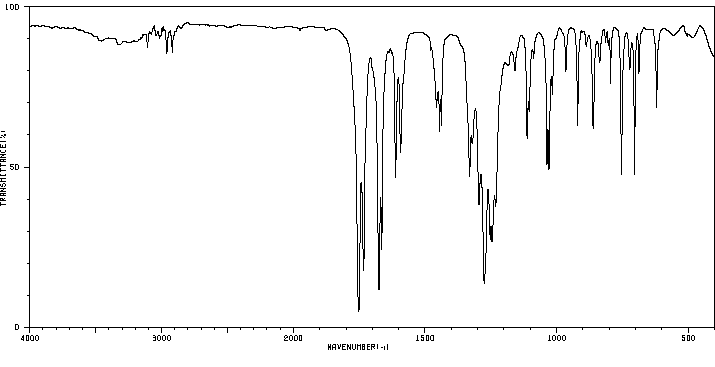2-[二(甲氧羰基)]甲基-3-氯-1,4-萘醌 | 25932-83-6
中文名称
2-[二(甲氧羰基)]甲基-3-氯-1,4-萘醌
中文别名
——
英文名称
2-[di(methoxycarbonyl)]methyl-3-chloro-1,4-naphthoquinone
英文别名
Dimethyl (3-chloro-1,4-dioxo-1,4-dihydro-2-naphthyl)malonate;dimethyl 2-(3-chloro-1,4-dioxonaphthalen-2-yl)propanedioate
CAS
25932-83-6
化学式
C15H11ClO6
mdl
——
分子量
322.702
InChiKey
PMCVROYHZJIALF-UHFFFAOYSA-N
BEILSTEIN
——
EINECS
——
-
物化性质
-
计算性质
-
ADMET
-
安全信息
-
SDS
-
制备方法与用途
-
上下游信息
-
文献信息
-
表征谱图
-
同类化合物
-
相关功能分类
-
相关结构分类
计算性质
-
辛醇/水分配系数(LogP):2.2
-
重原子数:22
-
可旋转键数:5
-
环数:2.0
-
sp3杂化的碳原子比例:0.2
-
拓扑面积:86.7
-
氢给体数:0
-
氢受体数:6
反应信息
-
作为产物:描述:氯丙二酸二甲酯 、 2-氯-1,4-萘醌 在 1,8-二氮杂双环[5.4.0]十一碳-7-烯 作用下, 以 四氢呋喃 为溶剂, 反应 0.25h, 以73%的产率得到2-[二(甲氧羰基)]甲基-3-氯-1,4-萘醌参考文献:名称:在VNS和乙烯基亲核取代之间1,4-萘醌衍生物竞争氢的替代亲核取代(VNS)(S Ñ V)摘要:氯丙二酸二甲酯,2-氯乙酰乙酸乙酯和丙二酸二甲酯的碳负离子主要通过氢过程的替代性亲核取代或氧化亲核取代与萘醌衍生物反应。在2-卤代萘醌,这些反应比卤素的乙烯基亲核取代(S通常较快的过程中Ñ V)。将一个Cl取代基引入1,4-萘醌的2-位大大提高了其亲电子活性,导致碳氢原子在氢占据的位置更快地加成。另一方面,向2,3-二氯-1,4-萘醌中添加碳负离子的速度比向1,4-萘醌中添加碳负离子的速度慢。DOI:10.1016/s0040-4020(01)00962-0
文献信息
-
OKAMOTO MASAO; OHTA SHUNSAKU; TERADA SHIN-ICHIRO, YAKUGAKU DZASSI, YAKUGAKU ZASSNI, J. PHARM. SOS. JAR., 1979, 99, NO 12, 1+作者:OKAMOTO MASAO、 OHTA SHUNSAKU、 TERADA SHIN-ICHIRODOI:——日期:——
表征谱图
-
氢谱1HNMR
-
质谱MS
-
碳谱13CNMR
-
红外IR
-
拉曼Raman
-
峰位数据
-
峰位匹配
-
表征信息
同类化合物
(S)-溴烯醇内酯
(R)-3,3''-双([[1,1''-联苯]-4-基)-[1,1''-联萘]-2,2''-二醇
(3S,3aR)-2-(3-氯-4-氰基苯基)-3-环戊基-3,3a,4,5-四氢-2H-苯并[g]吲唑-7-羧酸
(3R,3’’R,4S,4’’S,11bS,11’’bS)-(+)-4,4’’-二叔丁基-4,4’’,5,5’’-四氢-3,3’’-联-3H-二萘酚[2,1-c:1’’,2’’-e]膦(S)-BINAPINE
(11bS)-2,6-双(3,5-二甲基苯基)-4-羟基-4-氧化物-萘并[2,1-d:1'',2''-f][1,3,2]二氧磷
(11bS)-2,6-双(3,5-二氯苯基)-4羟基-4-氧-二萘并[2,1-d:1'',2''-f][1,3,2]二氧磷杂七环
(11bR)-2,6-双[3,5-双(1,1-二甲基乙基)苯基]-4-羟基-4-氧化物-二萘并[2,1-d:1'',2''-f][1,3,2]二氧杂磷平
黄胺酸
马兜铃对酮
马休黄钠盐一水合物
马休黄
食品黄6号
食品红40铝盐色淀
飞龙掌血香豆醌
颜料黄101
颜料红70
颜料红63
颜料红53:3
颜料红5
颜料红48单钠盐
颜料红48:2
颜料红4
颜料红261
颜料红258
颜料红220
颜料红22
颜料红214
颜料红2
颜料红19
颜料红185
颜料红184
颜料红170
颜料红148
颜料红147
颜料红146
颜料红119
颜料红114
颜料红 9
颜料红 21
颜料橙7
颜料橙46
颜料橙38
颜料橙3
颜料橙22
颜料橙2
颜料橙17
颜料橙 5
颜料棕1
顺式-阿托伐醌-d5
雄甾烷-3,17-二酮








